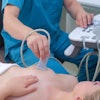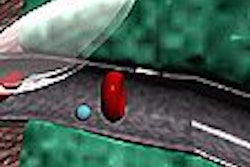(Ultrasound Review) In order to assess the accuracy of ultrasound in evaluating organ injury, radiologists from Vancouver Hospital studied 1,090 patients requiring in-hospital treatment over a two-year period. This research, published in the November issue of Radiology, established that "focused ultrasound has a high negative predictive value for major abdominal injury in patients with blunt abdominal trauma."
Other methods of evaluating this type of injury include diagnostic peritoneal lavage (DPL) and CT. DPL has a number of disadvantages: it is invasive, and because air and fluid are introduced during the procedure, this reduces the specificity of CT and ultrasound examinations performed after DPL.
According to the authors, CT is the preferred diagnostic test. However, patient transfer and preparation lead to treatment delays. Also, clinically unstable patients are not suitable for CT imaging. "Ultrasound is an accessible, portable, noninvasive, and reliable diagnostic tool for assessment of the presence of abdominal fluid," the authors state.
In the modified ultrasound examination, a focused ultrasound assessed whether fluid was present within the peritoneum or retroperitoneum. All examinations took place within 30 minutes of patient arrival at the emergency department, and took 10 minutes to perform.
The intraperitoneal and retroperitoneal spaces were examined for evidence of blood rather than specifically examining the organs. The Vancouver Hospital department has a strict policy of filling the urinary bladder in order to displace bowel and enable improved imaging of the cul-de-sac.
Patients with a negative ultrasound (89%) remained under observation for 12 hours, and a CT was performed if there was clinical deterioration. Patients with a positive (6%) or indeterminate (2.5%) ultrasound went on to spiral CT of the abdomen and pelvis.
There were four false-negative cases, one of which required surgery, and 19 false-negative results. This resulted in a focused-ultrasound sensitivity of 94% and a specificity of 98% for detecting hemoperitoneum.
This high negative predictive value reduces the number of emergency CT examinations of the abdomen and pelvis. The authors conclude that "focused abdominal ultrasound has a high negative predictive value for major abdominal injury in patients with blunt abdominal trauma."
"Focused abdominal US in patients with trauma"
Sattam S Lingawi* and Anne R Buckley
*Dept of Radiology
The University Hospital, King Abdulaziz University
PO Box 7363, Jeddah 21462, Saudi Arabia
Radiology 2000; 217:426–429
By Ultrasound Review
February 13, 2001
Click here to post your comments about this story. Please include the headline of the article in your message.
Copyright © 2001 AuntMinnie.com



















